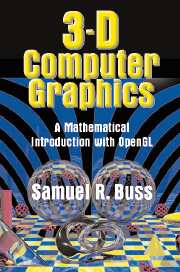Book contents
- Frontmatter
- Contents
- Preface
- I Introduction
- II Transformations and Viewing
- III Lighting, Illumination, and Shading
- IV Averaging and Interpolation
- V Texture Mapping
- VI Color
- VII Bézier Curves
- VIII B-Splines
- IX Ray Tracing
- X Intersection Testing
- XI Radiosity
- XII Animation and Kinematics
- A Mathematics Background
- B RayTrace Software Package
- Bibliography
- Index
- Plate section
XI - Radiosity
Published online by Cambridge University Press: 05 June 2012
- Frontmatter
- Contents
- Preface
- I Introduction
- II Transformations and Viewing
- III Lighting, Illumination, and Shading
- IV Averaging and Interpolation
- V Texture Mapping
- VI Color
- VII Bézier Curves
- VIII B-Splines
- IX Ray Tracing
- X Intersection Testing
- XI Radiosity
- XII Animation and Kinematics
- A Mathematics Background
- B RayTrace Software Package
- Bibliography
- Index
- Plate section
Summary
Radiosity is a global lighting method that tracks the spread of diffuse light around a scene. As a global lighting method, it attempts to simulate the effect of multiple light reflection. Unlike basic ray tracing, which tracks only the specular transport of light, radiosity tracks only the diffuse transport of light.
The goal of a radiosity algorithm is to calculate the illumination levels and brightness of every surface in a scene. As an example, consider a scene of a classroom with fluorescent light fixtures, painted walls, a nonshiny tile floor, and desks and other furniture. We assume that there are no shiny surfaces, and thus no significant amount of specular light reflection. All the light in the room emanates originally from the ceiling lights; it then reflects diffusely from objects in the room, especially from the walls and floor, providing indirect illumination of the entire room. For instance, portions of the floor underneath the desk may have no direct illumination from any of the lights; however, these parts of the floor are only partly shadowed. Likewise, the ceiling of the room receives little direct illumination from the overhead lights but still is not dark. As a more extreme case, the bottom sides of the desk tops are partly shadowed but are certainly not completely dark: they are illuminated by light reflecting off the floor.
- Type
- Chapter
- Information
- 3D Computer GraphicsA Mathematical Introduction with OpenGL, pp. 272 - 288Publisher: Cambridge University PressPrint publication year: 2003



